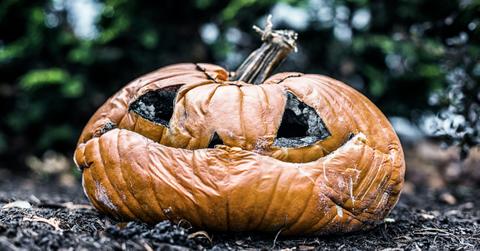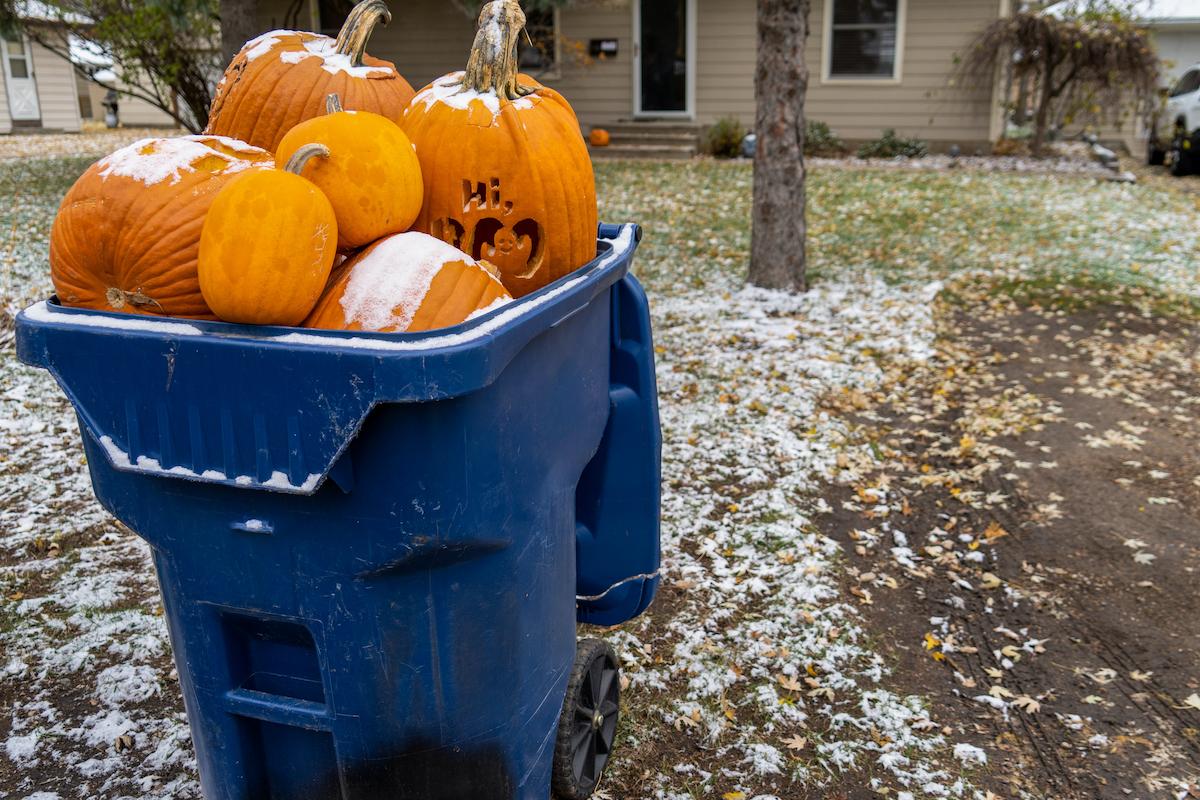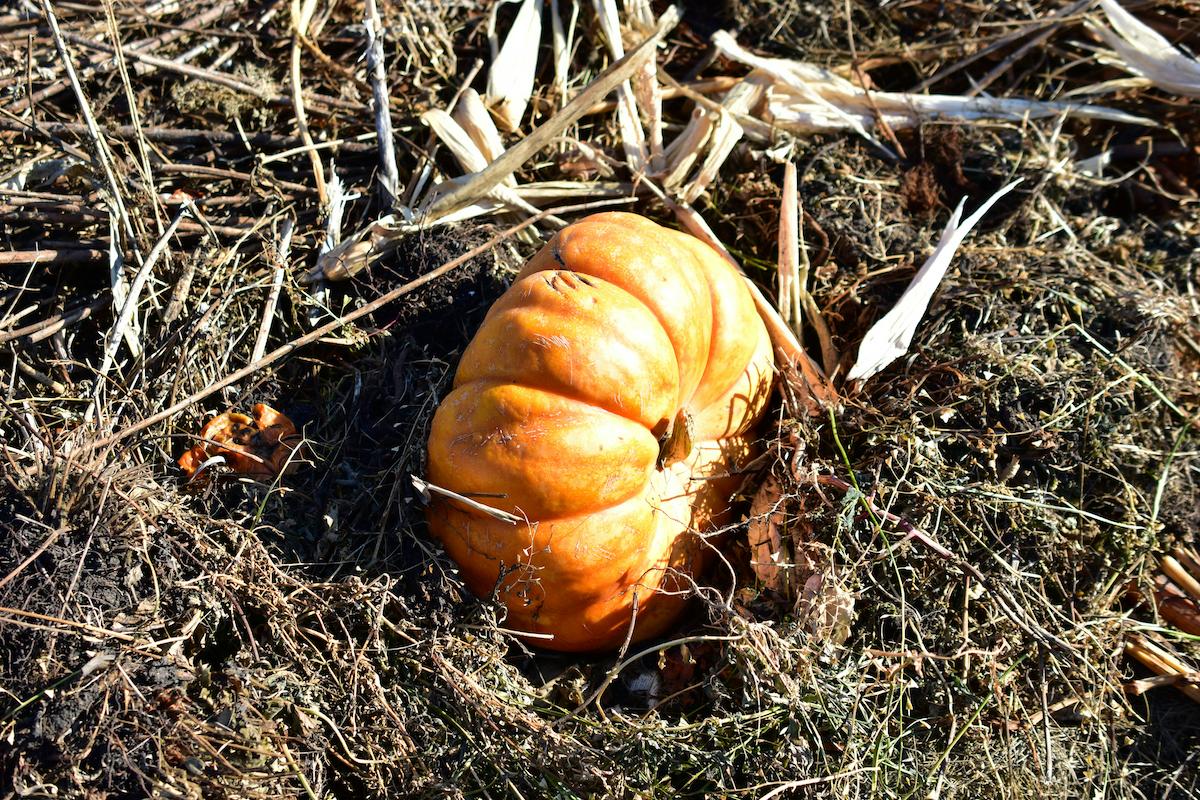What to Do With Old Pumpkins (Hint: They're Not Trash)
What can you do with old pumpkins?
Updated Nov. 2 2020, 9:50 a.m. ET

Pumpkins and jack-o'-lanterns are pretty much a zero-waster’s dream when it comes to holiday decor — they are all-natural, biodegradable, affordable, a DIY project in the making, and even edible! But in case you went a little overboard with your pumpkin-based Halloween decorations this year, we’ve got you covered with what you can do with old pumpkins to keep them out of the landfill.
Pumpkin recipes will spice up your fall.

If you’re carving any jack-o'-lanterns this year, make sure to save every bit of the pumpkin, from the insides to the skin to the seeds. The inside of the pumpkin can be chopped up and roasted as a fall veggie — you can enjoy that as is, or blend it into pumpkin soup or a pumpkin puree that can then be used to make delicious pumpkin chocolate chip cookies, pumpkin bread, or even pumpkin oatmeal. And the pumpkin seeds can be rinsed and roasted for a salty snack.
Additionally, if the pumpkin you've had on display in your home during the holiday season is still in good shape, but you're ready to start decorating for the next holiday, feel free to cook it up! As for eating the pumpkin that's been sitting on your stoop for the past month... that's your call.
Old pumpkins can be composted.

Whether the pumpkins you’ve put on your stoop are still in decent condition or completely rotten by the end of Halloween season, they are the perfect addition to any compost pile — just make sure to remove any decorations first, such as candles or ribbons. According to Earth911, you’ll also want to make sure no paint or plastic-based glitter goes in your compost pile — so simply chop or scrape off any non-organic sections and put those in the trash. And if you’ve yet to decorate your pumpkin this year, consider leaving the glitter and paint out of the equation so that you can compost or donate the entire thing at the end of the season!
If you want your pumpkin to break down quicker in your compost pile, or if your compost bin is small, you can roughly chop your pumpkin into pieces before composting it, especially the parts containing the pumpkin’s thick skin, according to the blog Can I Compost This?
Interestingly, Earth911 claims that pumpkin seeds thrown in a compost pile can germinate and start growing new pumpkins, and the website recommends leaving them out of the compost for that reason. If you’d rather not throw the seeds in the trash, consider either roasting and eating the seeds, grinding them up in a food processor before scattering them in your compost pile, or planting them in your garden and trying to grow pumpkins of your own for next year.
Composting a pumpkin is easy.

If you don’t typically compost, now might be the perfect time to start. Check out our guide to starting a backyard compost, and our guide to composting while living in an apartment.
You can also research to see if your town has a curbside composting program you can sign up for, or if your town offers compost drop-off points, often located at farmer’s markets, parks, and recycling centers.
Drop your pumpkin at a special community compost drop-off spot for pumpkins.
Many communities install temporary compost bins for residents to drop off their old pumpkins at the end of Halloween season — and they can be very effective at curbing landfill waste this time of year. For example, the city of Thunder Bay, Calif. has diverted nearly 400 tonnes of pumpkins from landfills and to the city’s composting facility since starting the program in 1995.
Some cities, such as New York City, host pumpkin smash events in early November. “Bring us your pumpkins and gourds,” New York City’s Sanitation Department proclaims, “you smash them, we’ll compost them!”
Zoos often accept old pumpkin donations.
In addition to municipalities, some zoos accept donations of old pumpkins, which zookeepers give to animals to play with and eat.
For example, the Cape May County Zoo in New Jersey accepts donations of pumpkins, which are given to animals for eating and “enrichment.”
The Rosamond Gifford Zoo in Syracuse, N.Y. offers an incentive in the weeks surrounding Halloween: Any child who brings and donates a large pumpkin receives free entry. The donated pumpkins are used as decorations around the zoo, and after Halloween celebrations are over, zookeepers give the pumpkins to animals to eat and play with, as reported by Syracuse.com
California’s Oakland Zoo works with local pumpkin patches who donate leftover pumpkins to the zoo for animals to eat; similarly, The Great Pumpkin Farm in Clarence, N.Y. donates pumpkin stalks and surplus pumpkins to the Buffalo Zoo.
Better yet, donate leftover pumpkins to an animal sanctuary.

While zoos capture wild animals, breed them, and force them to live in confined, cramped conditions much unlike their natural habitats, animal sanctuaries rescue animals from situations of abuse and neglect, making them a more ethical place to visit and support with your donations. So before offering your pumpkins up to your local zoo, check to see if a nearby animal sanctuary is accepting pumpkin donations!
Some sanctuaries that accept donations include Happy Trails Farm Animal Sanctuary in Ravenna, Ohio, Higher Ground Animal Sanctuary in Mead, Wash., Harvest Home Animal Sanctuary in Stockton, Calif., and North Mountain Animal Sanctuary, in Annapolis Valley, Nova Scotia, Canada.
Additionally, Pumpkins for Pigs is a resource of animal sanctuaries and farms that accept donated pumpkins, which are then fed to pigs.